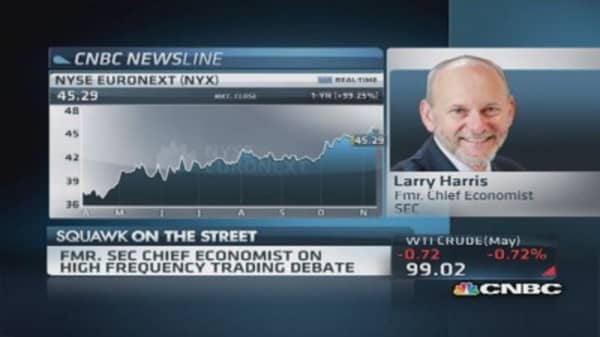Read MoreMichael Lewis's new book 'Flash Boys': Why the stock market is 'rigged'
Many studies directly address Lewis's concerns. For example, studies (including one of my own) show that the costs of filling huge institutional orders that are broken into thousands of trades are lower than they used to be. These orders are the ones that high frequency traders (HFTs) are most likely to front-run.
The fact that trading costs have dropped does not mean that we should continue to tolerate certain bad behaviors present in our markets. A few important changes could further lower trade costs for retail and institutional investors. Consider some specific suggestions:
Read MoreHFT can't front-run anyone: Algorithm specialist
For-profit exchanges have created exclusive high-speed data feeds and special order types that allow HFTs to profit from retail and institutional investors. The exchanges then tax the HFTs by charging them high fees for access to these special data feeds.
The SEC should ensure that all traders have equal access to data. These high-speed data feeds do not make our markets function better —just the opposite, they ultimately increase transaction costs for public investors. The SEC also should eliminate order types whose only purpose is to favor HFTs over public traders.
Most exchanges give brokers transaction-fee rebates when they route certain customer orders to their exchanges. Since almost all brokers keep the rebates instead of passing them through to their customers, the order routing decisions that brokers make often reflect their own profit calculations and not their clients' best interests. Not surprisingly, these corrupted routing decisions frequently allow HFTs to profit at the expense of the brokers' clients.
Read MoreWe knew someone was stealing from us: ex-Galleon trader
This system of rebates is known as maker-taker pricing. Trades occur when one trader (the taker) is willing to trade at a price offered by another trader (the maker). Exchanges that use the maker-trader pricing system charge high fees to the taker and rebate most of that fee to the taker.
The SEC should get rid of maker-take pricing, and its evil cousin, taker-maker pricing (makers pay high fees, with rebates to the takers). Instead, exchanges should simply price their services as they always did — by charging a small fee to the buyer and the seller.
Maker-taker and taker-maker pricing schemes also allow HFTs to front-run other traders by improving net prices by less than the one-cent minimum tick that historically has protected large traders from predation by faster traders. The SEC can limit these losses by banning the rebates.



